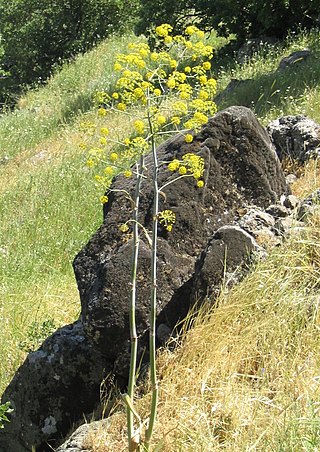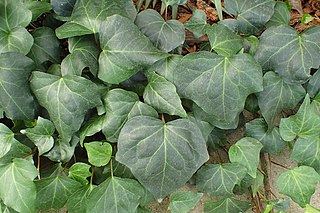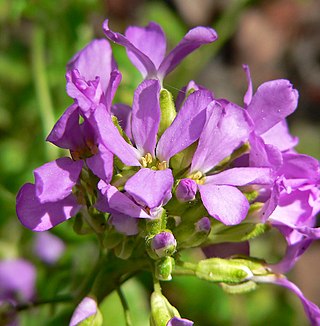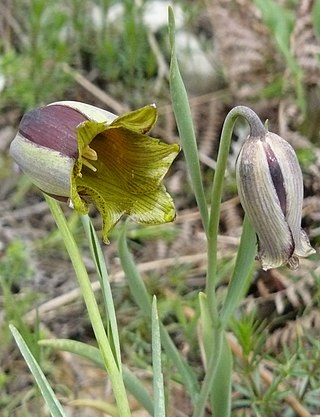
Dianthus is a genus of about 340 species of flowering plants in the family Caryophyllaceae, native mainly to Europe and Asia, with a few species in north Africa and in southern Africa, and one species in arctic North America. Common names include carnation, pink and sweet william.

Ferula is a genus of about 220 species of flowering plants in the family Apiaceae, native to the Mediterranean region east to central Asia, mostly growing in arid climates. They are herbaceous perennial plants growing to 1–4 m tall, with stout, hollow, somewhat succulent stems. The leaves are tripinnate or even more finely divided, with a stout basal sheath clasping the stem. The flowers are usually yellow, rarely white, produced in large umbels. Many plants of this genus, especially F. communis, are referred to as "giant fennel," although they are not fennel in the strict sense.

Hedera, commonly called ivy, is a genus of 12–15 species of evergreen climbing or ground-creeping woody plants in the family Araliaceae, native to Western Europe, Central Europe, Southern Europe, Macaronesia, northwestern Africa and across central-southern Asia east to Japan and Taiwan.

Lomelosia prolifera, the Carmel daisy, is a flowering plant of the family Caprifoliaceae. Its flowers in February to May, are creamy yellow, and when the petals are shed they leave a greenish-looking dried flower, good for arrangements. It is native to the eastern Mediterranean.

Delonix regia is a species of flowering plant in the bean family Fabaceae, subfamily Caesalpinioideae native to Madagascar. It is noted for its fern-like leaves and flamboyant display of orange-red flowers over summer. In many tropical parts of the world it is grown as an ornamental tree and in English it is given the name royal poinciana, flamboyant, phoenix flower, flame of the forest, or flame tree.

Arabis, or rockcress, is a genus of flowering plants, within the family Brassicaceae.

Arabis alpina, the Alpine rock-cress, is a flowering plant in the family Brassicaceae, native to mountainous areas of Europe, North and East Africa, Central and Eastern Asia and parts of North America. In the British Isles, it is only known to occur in a few locations in the Cuillin Ridge of the Isle of Skye. It inhabits damp gravels and screes, often over limestone.

Arabis hirsuta, known as hairy rock-cress, is a flowering plant of the genus Arabis in the family Brassicaceae. In previous North American works, this species has been broadly defined to include plants native to Europe, Asia, and the northern half of North America, but is now more often restricted to a narrower subgroup restricted to Europe.

Arabis blepharophylla is a species of flowering plant in the family Brassicaceae, known by the common names coast rock cress and rose rock cress. It is endemic to California, growing mostly in the San Francisco Bay Area and nearby low-elevation California Coast Ranges.

Arabis lemmonii is a species of flowering plant in the family Brassicaceae known by the common name Lemmon's rockcress. It is native to western North America from Alaska to California to Colorado, where it grows in a number of rocky habitat types.

Fritillaria acmopetala, the pointed-petal fritillary, is a species of flowering plant in the lily family Liliaceae, native to rocky limestone mountain slopes in the Middle East. It was described by the Swiss botanist Pierre Edmond Boissier in 1846.
Hedera cypria, is a species of Ivy which is endemic to the island of Cyprus. It is an evergreen climbing plant, growing slowly to 20–30 m high where suitable surfaces are available, and also growing as ground cover where there are no vertical surfaces. It climbs by means of aerial rootlets which cling to the substrate. It is more common at higher altitudes in rocky, shadowy riverine forest, over 400–650 m. In its natural habitat it can be distinguished easily from Hedera helix subsp. poetarum, also present, because the latter has yellow fruits, while Hedera cypria is always black-fruited.

Bosea cypria is a species of flowering plant in the Amaranthaceae family. It is a highly branched, evergreen shrub, 1–2 m high, erect, suberect, or hanging on walls, cliffs or trees, with hairless angular shoots. Leaves, opposite, simple, entire-+ elliptical, 2-6 x (1-2-3) cm, hairless, petiolate, dark green, occasionally red green. Flowers in branched spikes, hermaphrodite or unisexual 5-merous, very small, green brown, the floral symmetry is actinomorphic. The fruit is a globose red berry. Flowers from April to July. It is endemic to Cyprus and in the local Greek Cypriot dialect it is called ζουλατζιά

Sideritis cypria, the Cyprus ironwort, is a species of flowering plant in the family Lamiaceae. Erect perennial herb with a woody base, 60 cm high, with densely hairy tetragonal shoots. Leaves, opposite, simple, obscurely serrate, densely hairy, thick, oblanceolate, 3-12 x 1–5 cm. Flowers in verticillasters subtended by the cup-like bracts, zygomorphic, corolla bright yellow. Flowers from June to August. Fruit of 4 nutlets.
Pimpinella cypria, common name Cyprus burnet-saxifrage and locally Kıbrıs Pimpinela, is a herbaceous perennial plant belonging to the family Apiaceae.
Sedum lampusae is a species of flowering plant in the family Crassulaceae. It is an erect herb to 50 cm, dying after one flowering. Basal leaves flat, glaucous, fleshy, spoon-shaped, 4–10 cm long, forming neat rosette which usually shrivels before the flowers open; steam leaves progressively smaller; inflorescence a long cylindrical or pyramidal spray, flowers numerous, crowded, brownish green, calyx-lobes and petals both 5, the latter narrow, pointed, 4 mm long, with a dark central vein. Stamens 10, follicles usually 5, erect, 5 mm long. Flowers from June to August. Common name is Lapta Damkoruğu.
Rosularia cypria is a tufted perennial with grey-green, sticky-downy spoon-shaped fleshy leaves, 3–4 cm long, in a loose rosette above an often bare basal trunk; flowering stems to 20 cm, carrying a few more similar leaves; flowers in terminal sprays to 12 cm long with leaf like bracts of diminishing size; calyx densely glandular with 5 deep-cut, broad, lobes forming a 5-angled pyramid; corolla-lobes white, recurved, 8–10 mm long with slender points; fruits comprising 5 papery, many-seeded follicles, circa 4 mm. Flowers from April to July. Common name Kıbrıs Göbekotu.
Ferula cypria, the Cyprus fennel, is an erect perennial herb up to 1 m high with sulcate stems. The compound alternate leaves are hairless and 4-pinnate, 25-45 x 20–30 cm, final segments are very small, linear and acute. The inconspicuous yellowish flowers are repeatedly branched in pyramidal inflorescences. Flowers from May to June. The fruit is a dry hairless schizocarp.

Tulipa cypria, the Cyprus tulip, is a tulip, an erect perennial bulbous herb, 15–40 cm high, with glabrous, glaucous leaves. The four leaves are alternate, simple, entire, fleshy, the two lower ones larger, lanceolate, 10-20 x 2–6 cm, with conspicuously undulate margins, the two higher much smaller, nearly linear. One terminal showy flower, perianth cup shaped, of six free, petaloid segments, 2.5-9 x 1-3.5 cm, with dark blood-red colour, internally with a black blotch bordered by a yellow zone. It flowers March–April. The fruit is a capsule.
Lactuca cypria, the Cyprus lettuce, is a biennial, erect herb with glandular, hairy stems and a globose rhizome. Leaves alternate, simple, the basal large, oblong, petiolate, 10-15 x 5–7 cm, pinnatisect with a suborbicular terminal lobe, the upper smaller, often with a profound purple colour at the lower surface. Flowers in heads, capitula in corymbs, florets pale yellow, all ligulate, flowers April–July, fruit a pappose achene.













